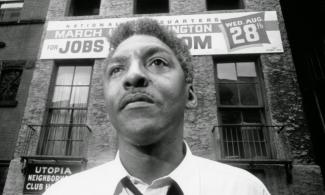
I first saw Rustin when I was a young lad of 15. It was in Trafalgar Square, London, in April, 1958 at the first “Ban the Bomb” rally. He was tall and slim and spoke clearly, distinctly, and energetically, with Nelson’s Column rising iconically at his back. Rustin was the only American and Black person to speak at the rally. (See video below).
Our paths and passions crossed (his major and mine minor) from that Easter Friday 1958 to today and beyond. The key personal links to Rustin for me are, Peace Activism, the Peace Sign, Ending Poverty, Fighting Racism, the March on Washington, Penn South Cooperative Housing and Japanese-American Imprisonment.
At that rally, the Campaign for Nuclear Disarmament (CND) first revealed the now ubiquitous peace sign. Rustin was the American who brought the Peace Sign to the USA.
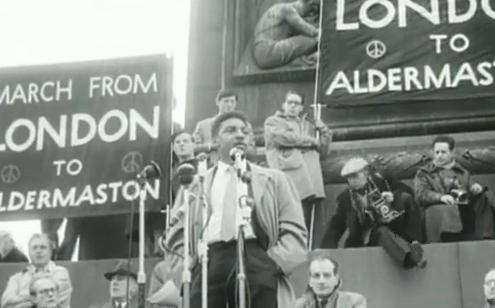
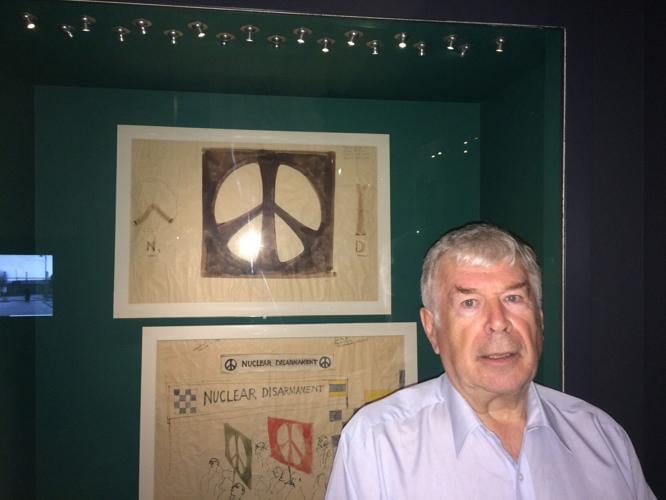
In 2023, “Rustin” was released by Netflix as a full-length movie about his life. The first fifteen minutes of the film mostly take place in 1963, at two different co-op apartments in Penn South, a limited equity housing co-op at 8th Avenue, New York City.
The link there is that in helping to create the National Consumer Cooperative Bank (NCCB), I attended meetings at Penn South in NYC in the early 1980s. At the time, I did not know Bayard Rustin still lived there (Rustin died there in 1987). I shared the same roof as Rustin when I stayed in the co-op apartment of Dave Smith, then President of Penn South. Smith was one of the great outspoken supporters of what NCCB could do for limited equity housing cooperatives. As co-leader of the California effort to get Congress to pass the NCCB Bank Bill, the Penn South union-sponsored low-moderate-income housing co-op was a poster child for those who would be benefited.
Later, while writing about the Penn South Co-op’s role in birthing the idea of the March on Washington, I came across the link to Rustin’s partner, Walter Naegle. I shared emails with Naegle that I had first seen Rustin in London in 1956, and since that time, our paths and interests had often crossed. Naegle shared with me a personal story that related specifically to the Penn South Co-op. The co-op apartments at Penn South in NYC were very low-cost given it was a limited equity housing co-op. However, given that Rustin was over 30 years older, he would likely die before Naegle. The laws at the time (the 1950-60s) did not allow gay people to marry and the by-laws of Penn South ordained that a co-op apartment could only be passed down to either the remaining legal spouse or the children of the member.
With Naegle not legally fitting either category upon Rustin’s death, he was destined to lose his ability to live in the co-op apartment. In a brilliant move, Rustin adopted Naegle as his son. When the law confirmed that Naegle was his legal son, Rustin added Naegle’s name to his co-op membership and lease. Here in 2024, Naegle at 76 is a co-op member and still living in Rustin’s co-op apartment. It has been over 30 years since Rustin’s death in 1987.
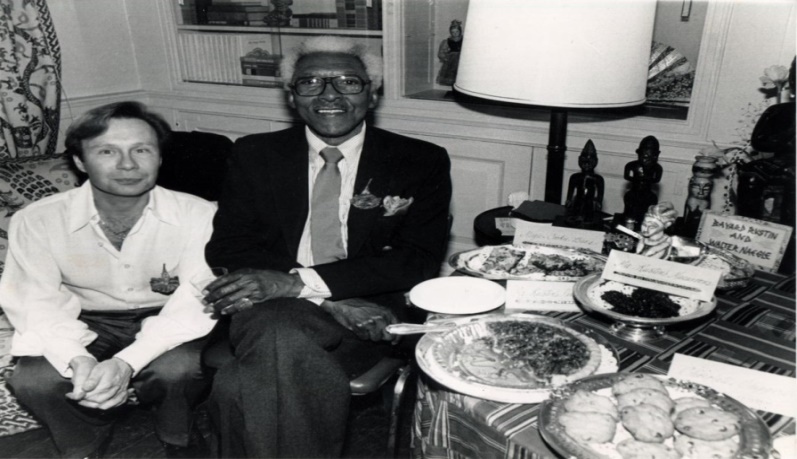
Two co-op apartments at the Penn South Co-op played a most critical role in the birth, initiation and planning of the March on Washington. One of the co-op apartments is Rustin’s own and the other co-op apartment is that of Rachelle Horowitz, then a young labor organizer. (I interviewed her by phone and email, and met her in DC).
It is in Bayard’s distinctly furnished apartment that the first discussions took place of the March on Washington. At that first meeting were Bayard, his then partner Tom Kahn and Congress on Racial Equality (CORE) organizers, Norman and Velma Hill and Rachelle Horowitz. (all of them at one point member/residents at Penn South). As time went on, the meetings brought in more people and the organizing phase began.
In the film, you can see a gathering of activists in Rachelle Horowitz’s co-op apartment. Among those seen on screen are many of the key people that organized the March on Washington. One of them seen in Rustin’s co-op apartment is one of my co-op heroes: Ella Baker who developed cooperatives for the NAACP and other groups.
Rachelle Horowitz has recounted to me that over the six months working with Rustin, she housed several of the March’s activists at her co-op apartment. During the summer of 1963, Horowitz was hosting Eleanor Holmes Norton (now the non-voting Congress member for Washington, DC) and two organizers from the Student Non-Violent Coordinating Committee (SNCC) from Mississippi, the sisters Joyce and Dorie Lander.
Bob Dylan had been smitten by Dorie and came over to the Horowitz apartment in the late evening to serenade her with songs he was practicing to sing at the March. Dylan also practiced another song, “Outlaw Blues,” written with Dorie in mind, for a Civil Rights fundraiser concert at which Dylan was going to sing in Mississippi.
On top of all this activity in her small apartment, John Lewis also turned up. He had been told by his hotel to stop practicing out loud his March on Washington speech as the booming noise spreading through the plaster board walls was disturbing other guests. As a result, Horowitz invited Lewis over to practice his speech in her sound proofed brick wall co-op apartment.
Velma Hill recounted to me that, “Because the four young workers on the ‘March’ had to get some sleep, Rachelle Horowitz had the historical task of at different times kicking both Dylan and John Lewis out of her co-op apartment.”
From a small office in Harlem, the Penn South contingency was at the heart of organizing the March on Washington. At 24, and without a driver’s license, Horowitz headed up the plan to get 250,000 people by plane, train, bus and car to the March.
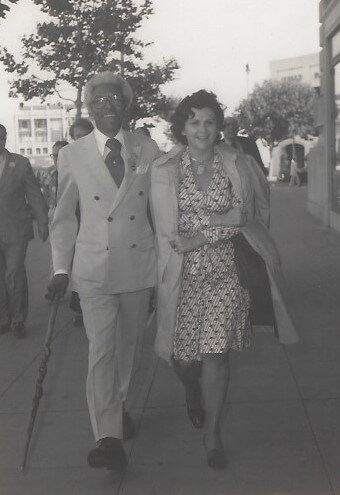
remained lifelong friends. Horowitz now lives in Washington DC.
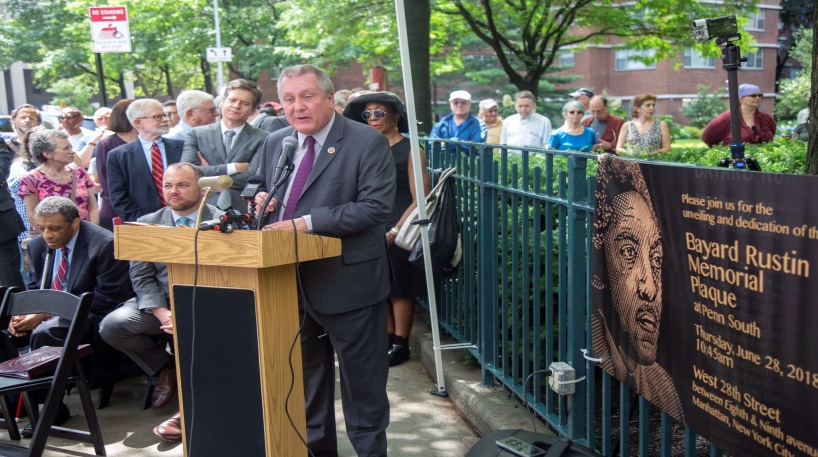
When it was proposed by A. Philip Randolph that his long time skilled advisor Rustin be named as the Director of the March, Roy Wilkins, head of the NAACP angrily vetoed the appointment. Wilkins did not want a gay former communist to be linked with the March at all never mind being the face of it1 . As a result, A Philip Randolph, the revered President of the Brotherhood of Sleeping Car Porters, stepped forward to be the Director. Wilkins was gratifyingly pleased and voted for the motion. As Director, Randolph then astutely appointed Rustin as his chief organizer. Although Rustin spoke at the March he was the only speaker not named in the program.
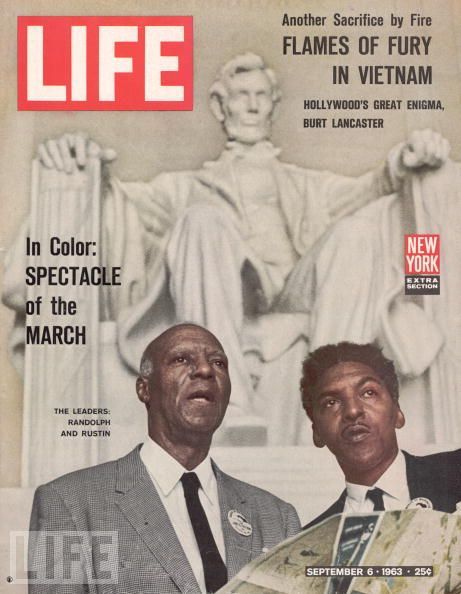
Japanese-American Recriminations and Redress
I have written a considerable number of published articles about the unconstitutional imprisonment of over 110,000 Japanese-Americans in Concentration Camps during the Second World War. The government act is one of the worst travesties of justice in the history of the USA.
A few years ago, by chance, I came across a reference for Bayard Rustin and the camps. Digging deeper, I found that in 1942, Bayard Rustin came to the concentration camp at Manzanar in California to give a talk on pacifism and civil disobedience. How he was invited and how he got there is still a mystery. There was a large busy co-op store (2nd largest food co-op in the US in 1943) run by the imprisoned at Manzanar with 11,000 built in member-shoppers. I feel sure there was a co-op connection among the conscientious objectors who staffed many of the co-ops in the camps.
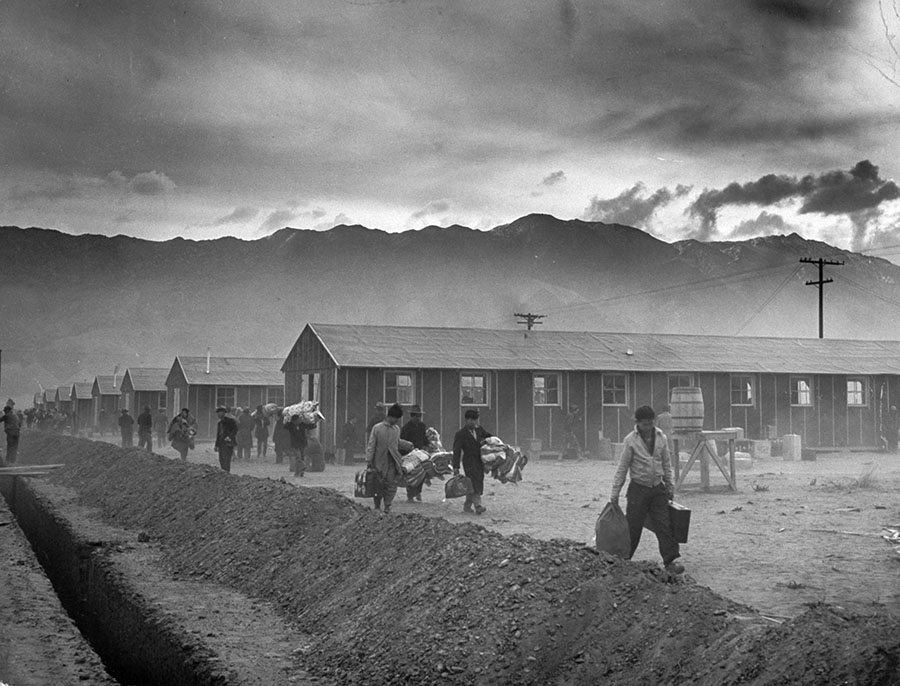
Rustin was working for the Fellowship of Reconciliation (FOR) and had been sent to California to do his best to protect the properties of the imprisoned Japanese-Americans. Regretfully, government entities took over much of what had been owned, impounded the property, and sold it off cheap at auctions. Goods valued at hundreds of millions of dollars were illegally taken from the Japanese-Americans. I am still mystified that Rustin and I shared the same interest in this unfortunate slice of American history.
My Cooperative Hall of Fame Induction, the Martin Luther King Jr, Suite at the Willard Hotel and Rustin’s & Lewis’ Presence
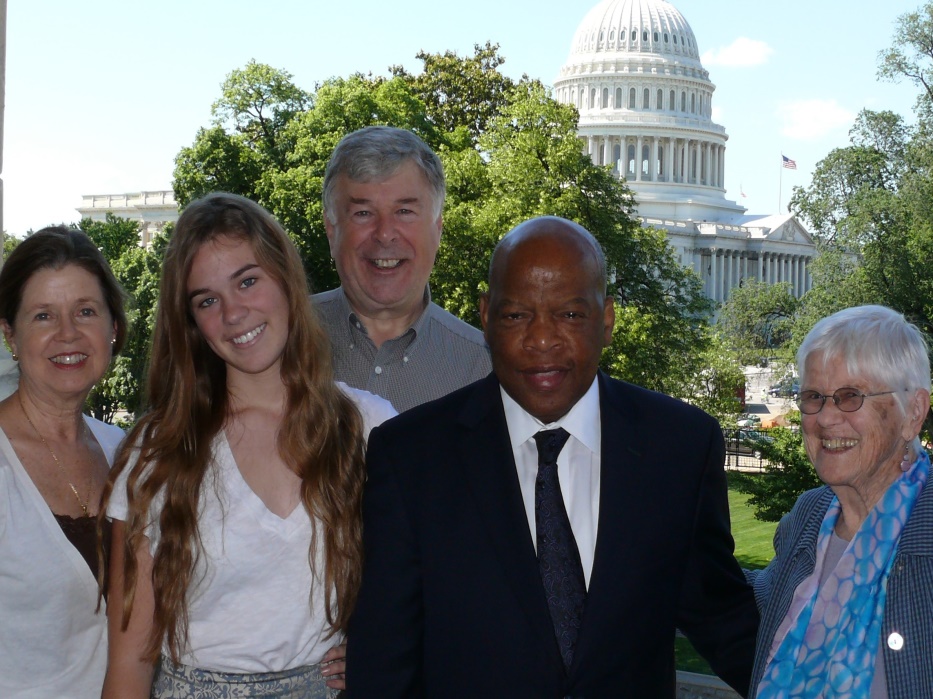
My family and I went to Washington, DC, in 2010 for my induction into the Cooperative Hall of Fame. One special part of that event was a private over one hour audience with Congress Member John Lewis. Lewis and I had both worked on setting up the National Cooperative Bank. Lewis had also counselled me on my work setting up the first legal black co-op in South Africa.
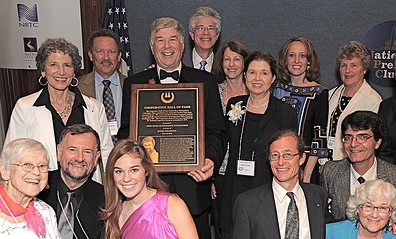
To celebrate the occasion, I reserved a suite at the Willard Hotel to host a reception for my family and friends. The suite I specifically reserved was the Martin Luther King, Jr. Suite on the third floor. In the middle of the night, I woke just as MLK had done to do more work on his “I Have A Dream” speech, and me to write the introduction to at that time my intended book on Cooperatives: “Against Slavery and For Civil Rights.”
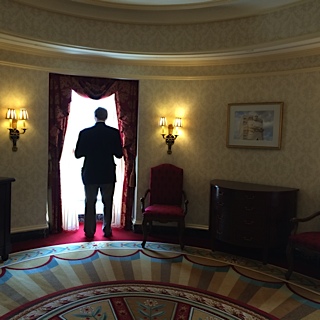
DT in the Martin Luther King Jr Suite at the Willard Hotel.
During those three days, I was enveloped in the presence of Martin Luther King, Jr., working among his family and supporters. One of the frequent visitors to MLK in that suite would, of course, have been Bayard Rustin as the organizer of the March on Washington. Lewis and other March leaders would have also have come to the Willard for meetings. The King Suite was a rich repository of Civil Rights memories for that momentous day.
Once again, over fifty years later, Bayard Rustin and I were in the same place for the same reasons. It felt good to be doing the work I do to build cooperatives and social housing. More importantly, it felt right that Bayard Rustin is now being commemorated for all the un-thanked work he did for so many years. In 1963, because he was gay, Rustin was the only speaker at the March on Washington not in the program. Today thankfully is an era when Bayard Rustin does not need to hide or to be hidden anymore.
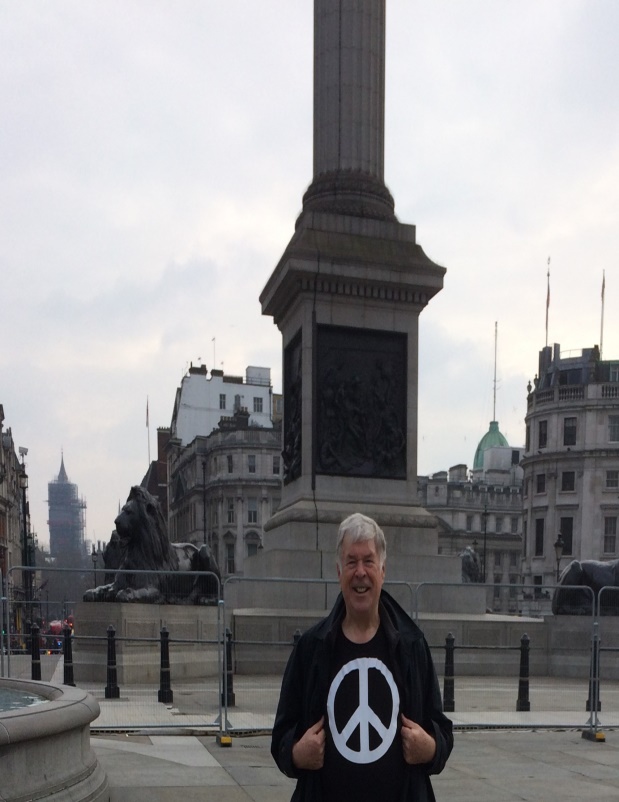
© Copyright 2024, David J. Thompson. Printed with permission.
- 1At this FBI web site https://vault.fbi.gov/bayard-rustin/bayard-rustin-part-06-of-07/view, you can see a seven page overview of the records of Rustin’s phone being tapped by the FBI for years.
Citations
David J. Thompson (2024). Bayard Rustin: The Links in Our Lives. Grassroots Economic Organizing (GEO). https://geo.coop/articles/bayard-rustin-links-our-lives


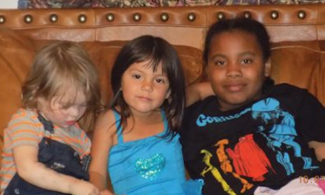

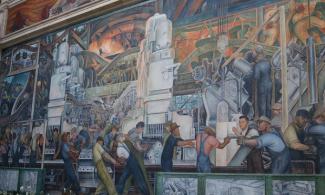
Add new comment